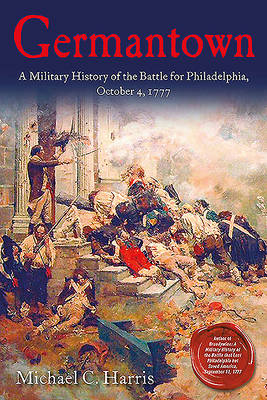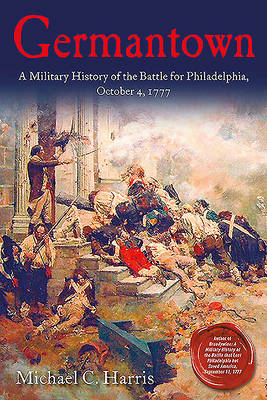
- Retrait gratuit dans votre magasin Club
- 7.000.000 titres dans notre catalogue
- Payer en toute sécurité
- Toujours un magasin près de chez vous
- Retrait gratuit dans votre magasin Club
- 7.000.0000 titres dans notre catalogue
- Payer en toute sécurité
- Toujours un magasin près de chez vous
Germantown
A Military History of the Battle for Philadelphia, October 4, 1777
Michael C Harris
Livre relié | Anglais
40,95 €
+ 81 points
Description
This book is the first complete study merging the tactics, politics, and strategic importance of the Battle of Germantown during the American Revolutionary War.
Today, Germantown is a busy neighborhood in Philadelphia. On October 4, 1777, it was a small village on the outskirts of the colonial capital whose surrounding fields and streets witnessed one of the largest battles of the American Revolution. The bloody battle represented George Washington's attempt to recapture Philadelphia, but has long been overshadowed by better-known events like Brandywine, Saratoga, and Valley Forge. Award-winning author Michael C. Harris's impressive Germantown: A Military History of the Battle for the Control of Philadelphia, October 4, 1777, elevates this important action from obscurity in the first full-length study of this pivotal engagement.
General Sir William Howe launched his campaign to capture Philadelphia in late July 1777, with an army of 16,500 British and Hessian soldiers aboard a 265-ship armada sailing from New York. Six difficult weeks later, Howe's expedition landed near Elkton, Maryland, and moved north into Pennsylvania. Washington's rebel army did all it could to harass Howe and fought and lost a major battle at Brandywine on September 11. Philadelphia fell to the British.
On October 4, obscured by darkness and a heavy morning fog, Washington launched a surprise attack on the British garrison at Germantown. His early attack found initial success and drove the British legions before him. The recapture of the colonial capital seemed within Washington's grasp until poor decisions by the American high command brought about a reversal of fortune and a clear British victory. Like Brandywine, however, the bloody fight at Germantown proved that Continental soldiers could stand toe-to-toe with British Regulars. The Battle of Germantown began a protected quasi-siege of the British garrison in Germantown prior to the travails soon to come that winter at Valley Forge.
Harris's Germantown is the first complete study to merge the strategic, political, and tactical history of this complex operation and important set-piece battle into a single compelling account. Following up on his award-winning Brandywine, Harris's sweeping prose relies almost exclusively on original archival research and a deep personal knowledge of the terrain. Complete with original maps, numerous illustrations, and modern photos, and told largely through the words of those who fought there, Germantown: A Military History of the Battle for the Control of Philadelphia, October 4, 1777 is sure to please the most discriminating reader and assume its place as one of the finest military studies of its kind.
Today, Germantown is a busy neighborhood in Philadelphia. On October 4, 1777, it was a small village on the outskirts of the colonial capital whose surrounding fields and streets witnessed one of the largest battles of the American Revolution. The bloody battle represented George Washington's attempt to recapture Philadelphia, but has long been overshadowed by better-known events like Brandywine, Saratoga, and Valley Forge. Award-winning author Michael C. Harris's impressive Germantown: A Military History of the Battle for the Control of Philadelphia, October 4, 1777, elevates this important action from obscurity in the first full-length study of this pivotal engagement.
General Sir William Howe launched his campaign to capture Philadelphia in late July 1777, with an army of 16,500 British and Hessian soldiers aboard a 265-ship armada sailing from New York. Six difficult weeks later, Howe's expedition landed near Elkton, Maryland, and moved north into Pennsylvania. Washington's rebel army did all it could to harass Howe and fought and lost a major battle at Brandywine on September 11. Philadelphia fell to the British.
On October 4, obscured by darkness and a heavy morning fog, Washington launched a surprise attack on the British garrison at Germantown. His early attack found initial success and drove the British legions before him. The recapture of the colonial capital seemed within Washington's grasp until poor decisions by the American high command brought about a reversal of fortune and a clear British victory. Like Brandywine, however, the bloody fight at Germantown proved that Continental soldiers could stand toe-to-toe with British Regulars. The Battle of Germantown began a protected quasi-siege of the British garrison in Germantown prior to the travails soon to come that winter at Valley Forge.
Harris's Germantown is the first complete study to merge the strategic, political, and tactical history of this complex operation and important set-piece battle into a single compelling account. Following up on his award-winning Brandywine, Harris's sweeping prose relies almost exclusively on original archival research and a deep personal knowledge of the terrain. Complete with original maps, numerous illustrations, and modern photos, and told largely through the words of those who fought there, Germantown: A Military History of the Battle for the Control of Philadelphia, October 4, 1777 is sure to please the most discriminating reader and assume its place as one of the finest military studies of its kind.
Spécifications
Parties prenantes
- Auteur(s) :
- Editeur:
Contenu
- Nombre de pages :
- 528
- Langue:
- Anglais
Caractéristiques
- EAN:
- 9781611215199
- Date de parution :
- 17-09-20
- Format:
- Livre relié
- Format numérique:
- Genaaid
- Dimensions :
- 155 mm x 231 mm
- Poids :
- 997 g

Les avis
Nous publions uniquement les avis qui respectent les conditions requises. Consultez nos conditions pour les avis.






